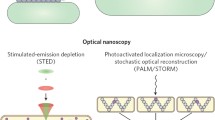Abstract
Visualizing the microbial cell surface by microscopy has been and still is a challenge. Fluorescence light-optical methods locate structures with accuracy in the lower nanometer range, scanning force microscopes record corrugations with angstrom sensitivity, and electron microscopy provides near atomic resolution of protein complexes. But if the surface of intact cells is to be investigated we are limited by several restrictions. What can microscopy achieve and which method is promising?
Similar content being viewed by others
Literatur
Tsiavaliaris G, Manstein DJ (2003) TIRF-Mikroskopie und ihre Anwendung in der Biologie. BIOspektrum 5:596–600
Pawley JB (2008) LVSEM for biology. In: Schatten H, Pawley JB (Hrsg) Biological low-voltage scanning electron microscopy. Springer, New York, S. 27–106
Müller D, Dufrêne YF (2011) Atomic force microscopy: a nanoscopic window on the cell surface. Trends Cell Biol 21:461–469
Schertel A, Snaidero N, Han H-M et al. (2013) Cryo FIBSEM: volume imaging of cellular ultrastructure in native frozen specimens. J Struct Biol 184:355–360
Engelhardt H (2013) Visualizing the bacterial cell surface: an overview. Meth Mol Biol 966:15–35
Engelhardt H (2012) Elektronenmikroskopie. In: Lottspeich F, Engels JW (Hrsg) Bioanalytik. Springer Spektrum, Heidelberg, S. 527–563
Rigort A, Bäuerlein FJB, Villa E et al. (2012) Focused ion beam micromachining of eukaryotic cells for cryoelectron tomography. Proc Natl Acad Sci USA 109:4449–4454
Eibauer M, Hoffmann C, Plitzko JM et al. (2012) Unraveling the structure of membrane proteins in situ by transfer function corrected cryo-electron tomography. J Struct Biol 180:488–496
Olmsted SB, Erlandsen SL, Dunny GM et al. (1993) High-resolution visualization by field emission scanning electron microscopy of Enterococcus faecalis surface proteins encoded by the pheromone-inducible conjugative plasmid pCF10. J Bacteriol 175:6229–6237
Dufrêne YF (2001) Application of atomic force microscopy to microbial surfaces: from reconstituted cell surface layers to living cells. Micron 32:153–165
Author information
Authors and Affiliations
Corresponding author
Additional information
Harald Engelhardt Jahrgang 1950. Biologiestudium und Promotion in Bonn. 1981–1982 Postdoc an der Universität Düsseldorf, ab 1983 am Max-Planck-Institut für Biochemie, Martinsried. Seit 1988 Leiter der Gruppe Mikrobielle Membran- und Zellwandproteine in der Abteilung Strukturbiologie.
Rights and permissions
About this article
Cite this article
Engelhardt, H. Abbildung mikrobieller Zelloberflächen. Biospektrum 20, 154–157 (2014). https://doi.org/10.1007/s12268-014-0421-6
Published:
Issue Date:
DOI: https://doi.org/10.1007/s12268-014-0421-6




